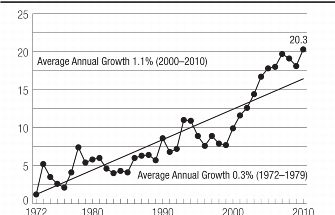Despite these financial challenges, in 2010 we were able to significantly increase operating efficiency.
Operating efficiency, as measured by Total Factor Productivity (TFP) increased 2.2 percent in 2010 as compared to 2009. This marks the ninth year of positive TFP growth since 2000 with cumulative TFP growth of 20.3% since 1972. Productivity gains are a result of effective workforce management, efficient use of material (supplies, services, and transportation), and maximizing the return on capital investments (mainly automation projects).
Work hours were reduced by 75 million, or 6.0%, in 2010 despite an increase of 740,000 delivery points during the year. Non-personnel expenses were reduced by 1.2% while mail volume declined 3.5%.
Work hour savings included approximately 26.6 million work hours in mail processing operations in 2010. This was accomplished through processing plant and network consolidations along with continued advancements in automation.
In 2009, the Postal Service consolidated carrier routes, eliminating over 11,000 routes, with an additional 1,100 routes eliminated in 2010. The net result of these actions helped drive a 20.1 million work hour reduction in City and Rural Delivery operations and a reduction of over 3,000 postal-owned vehicles.
Declines in customer mail volume coupled with increased electronic access to our services, such as Click-n-Ship, PC Postage, and Automated Postal Centers, helped reduce customer service work hours. These efforts have improved customer access and made possible an 18.1 million work hour reduction in customer service operations.
Overall spending reductions in 2010 also included a 24% decrease in capital expenditures. The capital spending freeze, initiated in 2009, limited capital spending to projects that are necessary for safety and health, to maintain operations, or provide future savings.
The following graph shows the TFP cumulative trend from 1972 through 2010.

